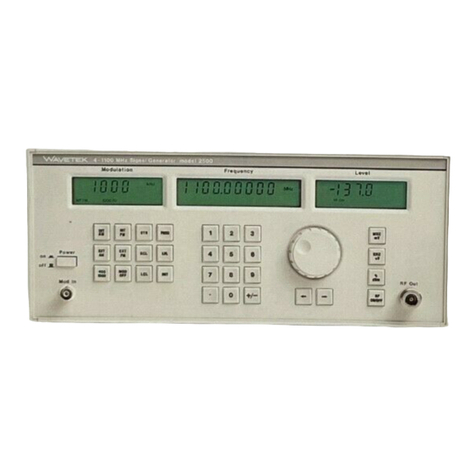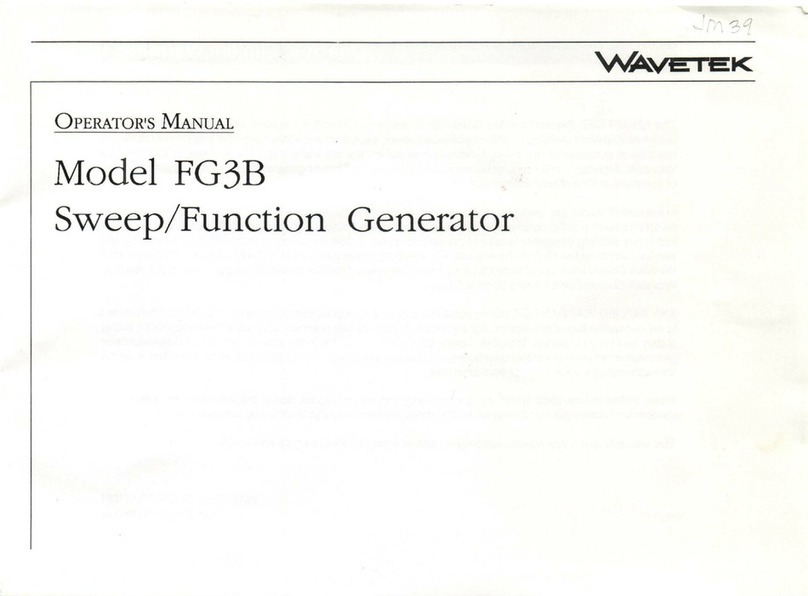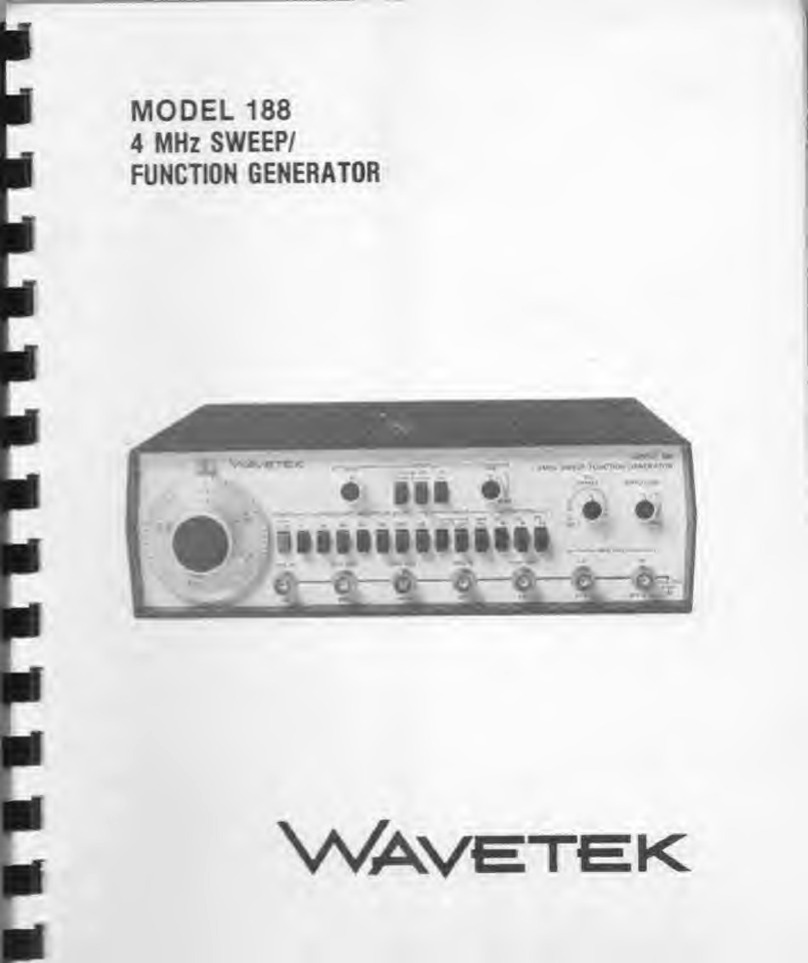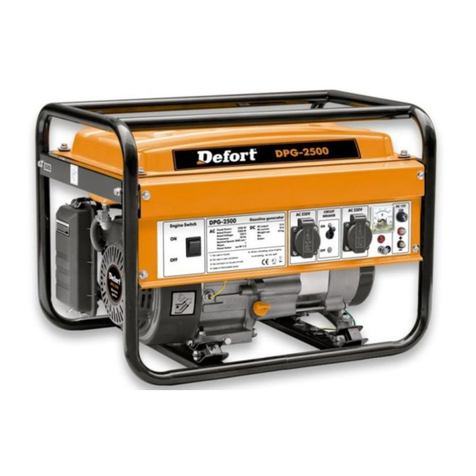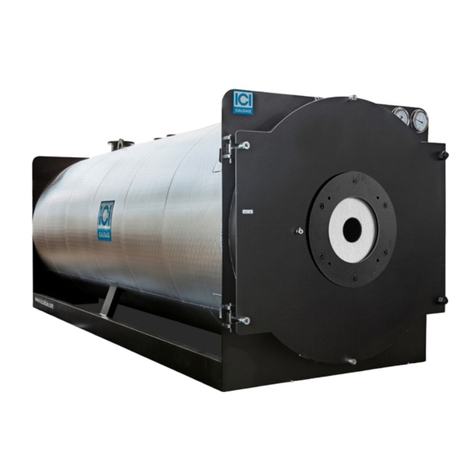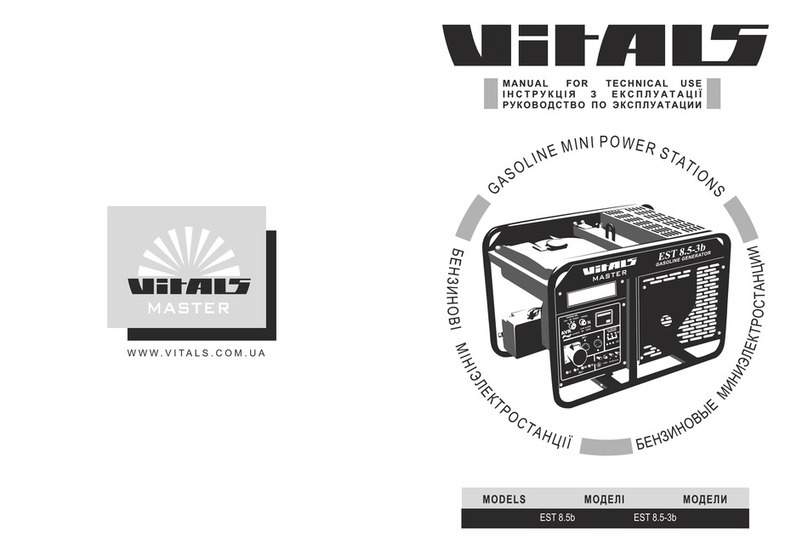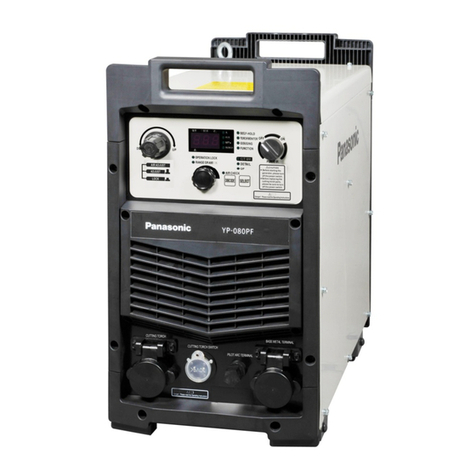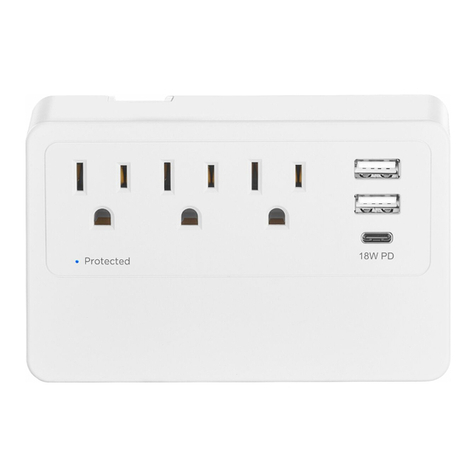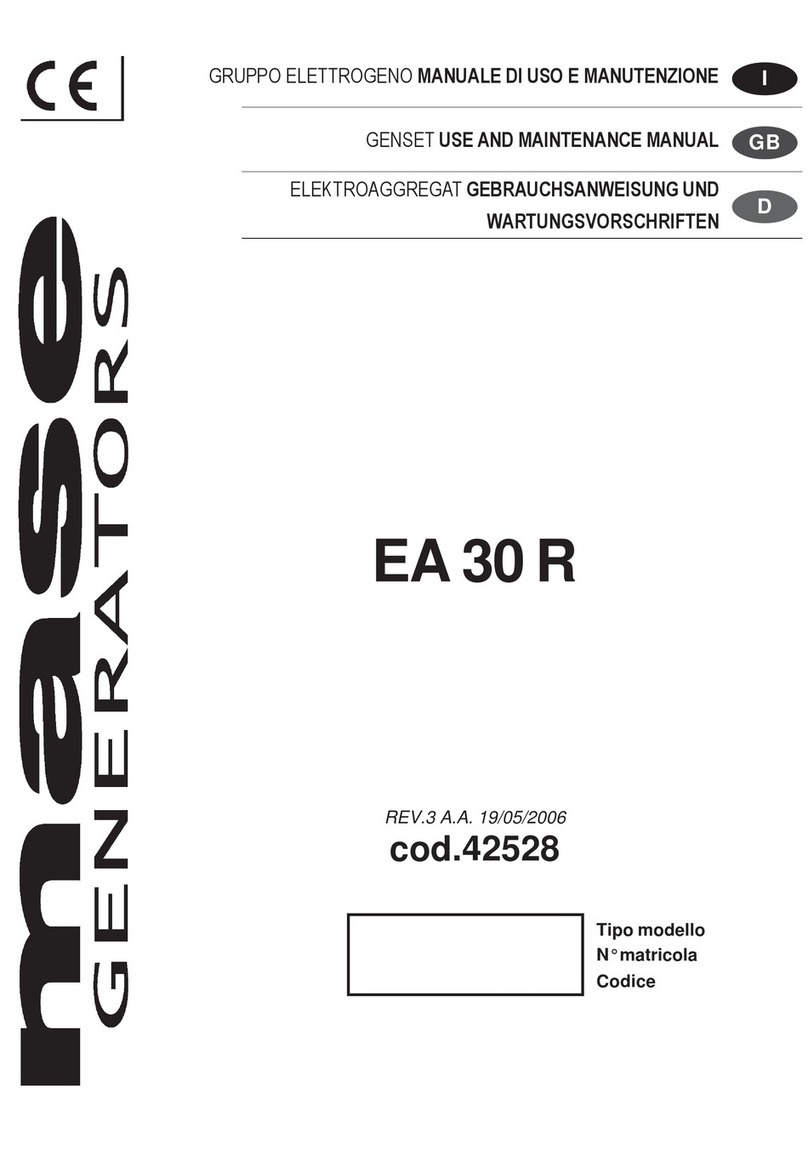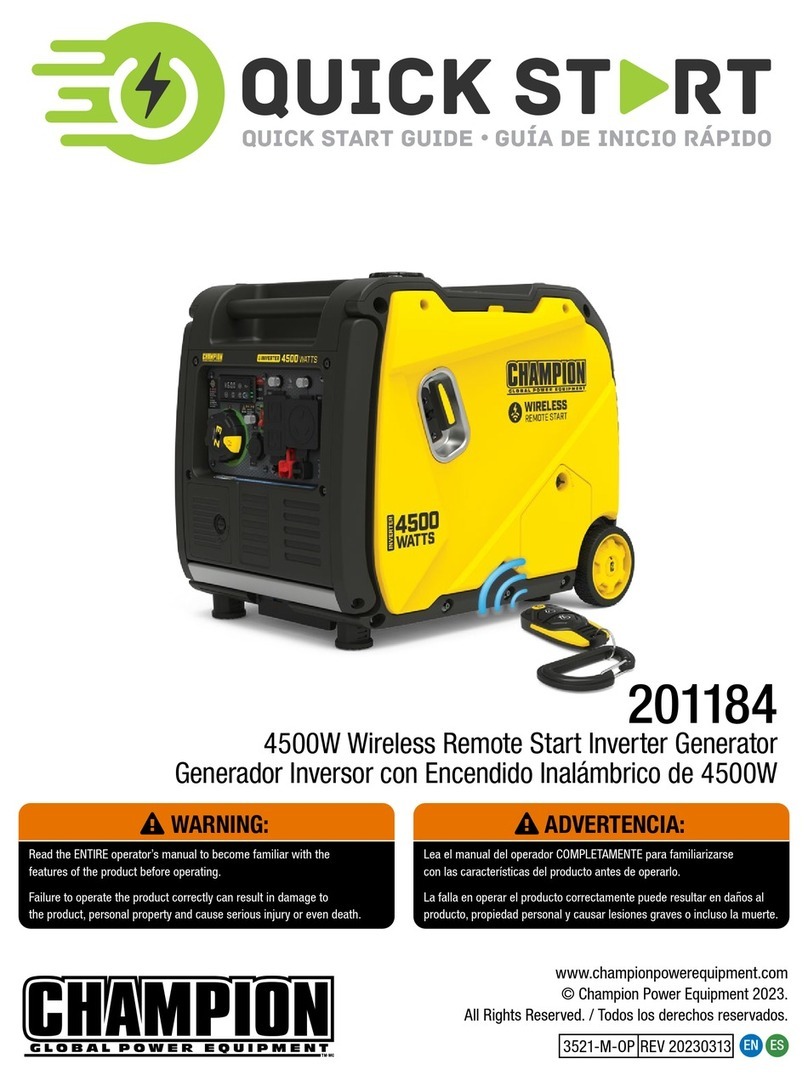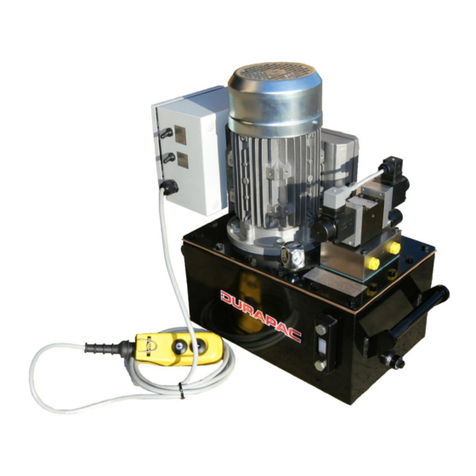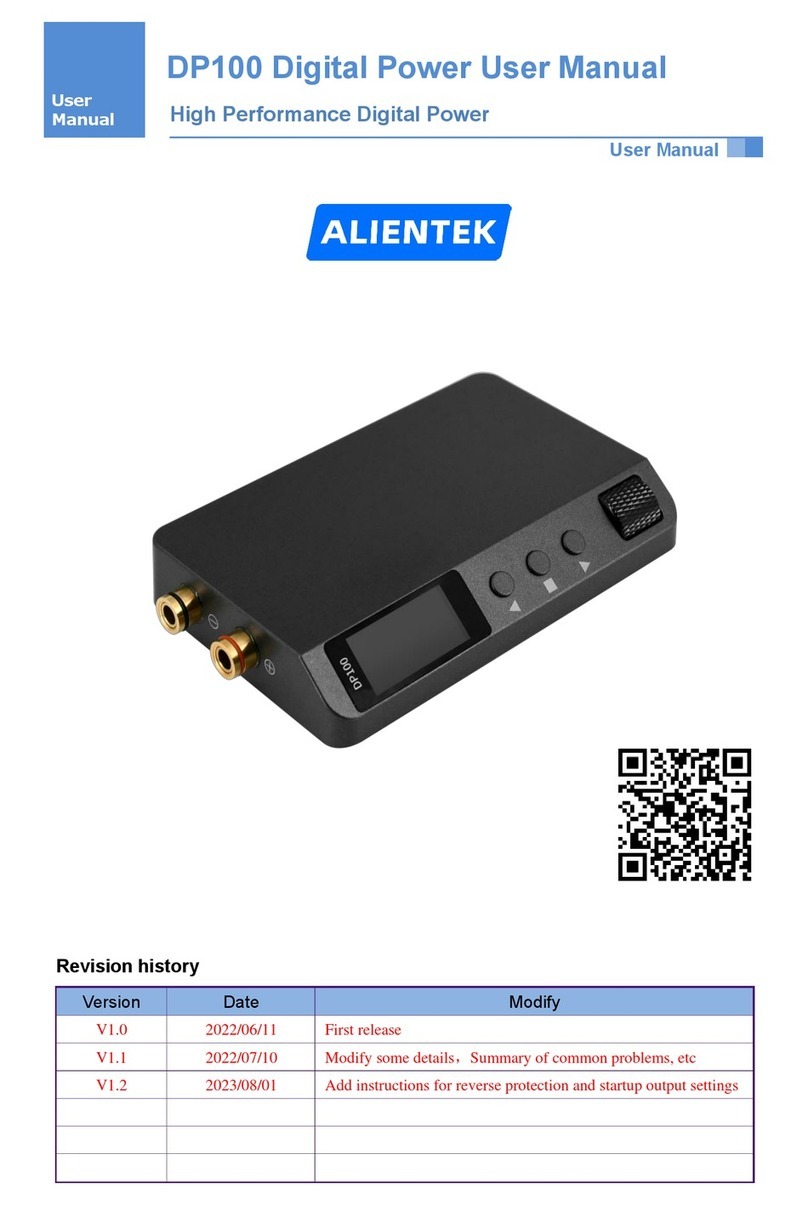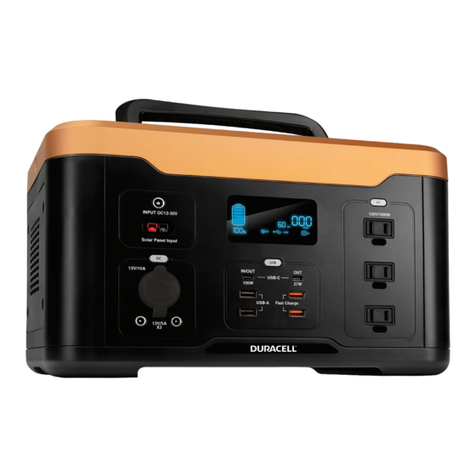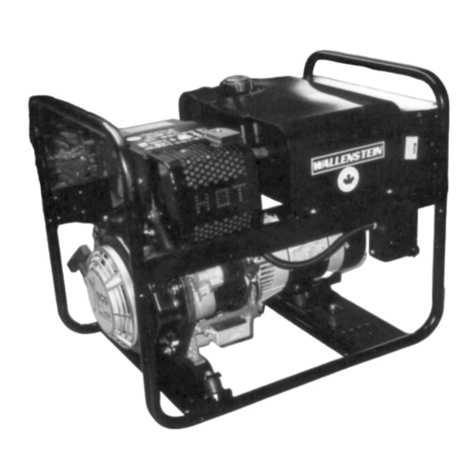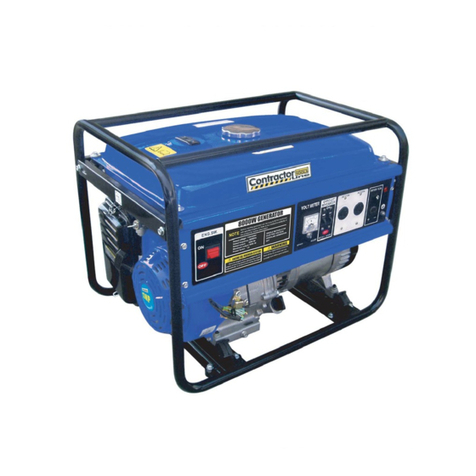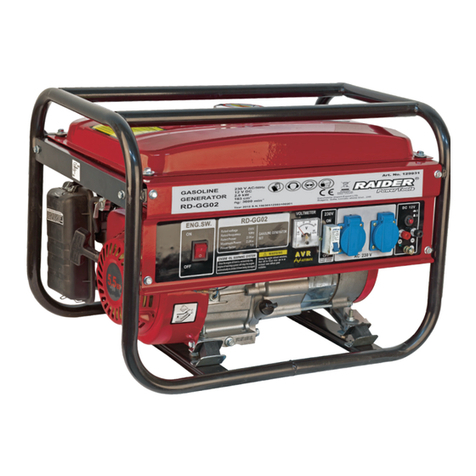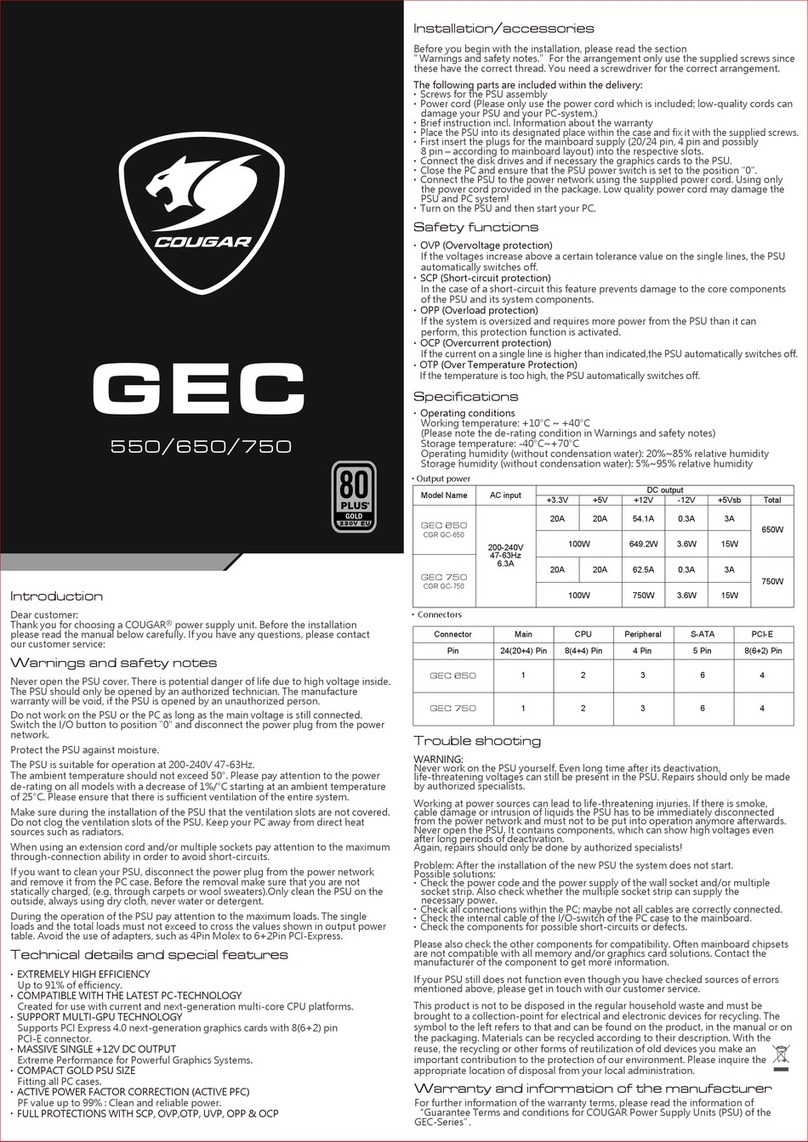Wavetek 150 User manual

Instruction Manual
MODEL 150
MODEL 155
PROGRAMMABLE VOLTAGE
CONTROLLED GENERATORS
8159 ENGINEER ROAD, SAN DIEGO, CALIFORNIA

Instruction Manual
MODEL 150
MODEL 155
PROGRAMMABLE VOLTAGE
CONTROLLED GENERATORS
VAvetek
8159 ENGINEER ROAD, SAN DIEGO, CALIFORNIA
Revised 8-66

WAVETEK MODEL 150 PROGRAMMABLE VOLTAGE-CONTROLLED GENERATOR
WAVETEK MODEL 155 PROGRAMMABLE VOLTAGE-CONTROLLED GENERATOR
ii

TABLE OF CONTENTS
Section Page
IINTRODUCTION AND GENERAL DESCRIPTION
Scope 1-1
General Description 1-1
Model 150 Programmable Voltage-Controlled
Generator 1-2
Model 155 Programmable Voltage-Controlled
Generator 1-2
Interface Accessories 1-3
II SPECIFICATIONS
Frequency Characteristics 2-1
Amplitude Characteristics 2-1
Outputs 2-1
Inputs 2-2
Waveform Purity 2-2
Physical Characteristics 2-2
Control Connector Wiring Data 2-3
III OPERATION PROCEDURE
General 3-1
Operation Procedures 3-1
IV THEORY OF OPERATION
VCALIBRATION
General 5-1
Test Equipment 5-1
Power Supply Board 5-1
Schmitt and Switch Board 5-1
Integrator Amplifier Board 5-2
Digital-to-Analog Board 5-2
Sine Converter Board 5-3
Output Amplifier Board 5-3
VI MAINTENANCE
General 6-1
No Output From Programmed BNC Connector 6-2

Section Page
VII PARTS LIST
General 7-1
List of Manufacturers 7-1
VIII SCHEMATIC DIAGRAMS
LIST OF ILLUSTRATIONS
Figure No. Page
4-
1VCG Functional Block Diagram 4-2
5-
3Sine Converter Board Output Waveform 5-4
5-4 Optimum Wave for Sine Converter 5-4
7-1 Chassis and Front Panel Assembly 7-2
7-2 Mother Board Assembly 7-3
7-3 Power Supply Assembly 7-7
7-4 Integrator Assembly .7-10
7-5 Dto AConverter Assembly 7-13
7-6 Sine Converter Assembly 7-17
7-7 Schmitt and Switch Assembly 7-20
7-8 Range and Trigger Assembly 7-23
7-9 Output Amplifier and Function As sembly 7-27
7-10 Extender Board 7-31
IV

WARRANTY
WAVETEK warrants instruments manufactured by it to have met WAVETEK's
published specifications at the time of shipment of such instruments, and agrees
to repair within one year of shipment, such instruments or their components
(excluding batteries), which under normal use are found to be defective as are-
sult of our manufacturing. Our obligation under this warranty is limited solely
to repairing any such instrument which in our sole opinion proves to be defective
when returned to our factory. Transportation to the factory is to be prepaid by
purchaser. Instruments returned to the factory will be accepted only when prior
authorization has been given by arepresentative of WAVETEK.
This warranty does not apply to any of our products which have been repaired or
altered by persons not authorized by WAVETEK, or not in accordance with in-
structions furnished by us. If the instrument is defective as aresult of misuse,
improper repair, or abnormal conditions or operations, repairs will be billed
at cost.
WAVETEK assumes no responsibility for its product being used in ahazardous
or dangerous manner either alone or in conjunction with other equipment.
WAVETEK assumes no liability for secondary charges or consequential dam-
ages, and in any event, WAVETEK's liability for breach of warranty under any
contract or otherwise, shall not exceed the purchase price of the specific instru-
ment shipped and as to which aclaim is made.
Any recommendations made by WAVETEK for the use of its products are based
upon tests believed to be reliable, but WAVETEK makes no warranty of the re-
sults to be obtained. This warranty is in lieu of all other warranties, expressed
or implied, and no representative or person is authorized to represent or as-
sume for us any liability in connection with the sale of our products other than
set forth herein.
V

SECTION I
INTRODUCTION AND GENERAL DESCRIPTION
SCOPE
This instruction manual provides instructions for operation, calibration, and
maintenance of WAVETEK Series 150 Programmable Voltage-Controlled Gen-
erators.
GENERAL DESCRIPTION
The WAVETEK 150 Series Programmable Voltage-Controlled Generators are
solid-state, multi-purpose function generators which produce sine, triangle
and square wave outputs. The 150 Series includes the Model 150 and the Model
155. Both models are completely programmable, using binary-coded-deci-
mal (BCD) control of frequency and amplitude. Frequency, waveform function,
and signal amplitude are selected by remote contact closures or logic levels.
Both models provide continuous and triggered operating modes. The Model
155 also includes local control by front panel digital switches which allow man-
ual control of frequency, waveform function, amplitude, and range.
The programmed BNC output of the 150 Series instruments provides any one of
the three waveform signals at any amplitude between 10 millivolts and 10 volts,
peak to peak, into a50jt load. The output frequency range is 0. 01 Hz to 1MHz,
in eight ranges. An analog voltage input (VCG) will vary the frequency through
each range to amaximum of Z0:1.
Both models also provide simultaneous sine, triangle, and square wave outputs
with constant amplitude over the entire frequency range of the instrument. The
output impedance of all outputs is 50rL.
The output signals may be continuous or may be triggered by a5volt gate or
pulse input. The trigger input may be specified for either polarity. In the trig-
gered mode, at least one complete cycle is generated for each trigger pulse.
The frequency of the cycle is determined by the programmed frequency and
range. If agate voltage is applied to the trigger input, numerous cycles at the
programmed frequency are generated during the period of the gate. Atrigger
pulse of shorter duration than one cycle of the frequency being generated will
produce one cycle.
Series 150 instrument are 5-1/4 inches high, 16 inches deep, and 19 inches
wide, and are contained in an enclosure which fits astandard RETMA 19-inch
relay rack. The solid-state electronic circuits are contained on plug-in glass-
epoxy circuit boards, interconnected through amother board. An extender
board is included in each instrument, to allow circuit boards to be operated
while extended outside the enclosure. The modular construction facilitates
1-1

calibration and maintenance to an extent not usually associated with complex
electronic equipment.
MODEL 150 PROGRAMMABLE VOLTAGE- CONTROLLED GENERATOR
The Model 150 Programmable Voltage-Controlled Generator is operated by re-
mote closures or logic levels in an 8-4-2-1 BCD code. Other input codes are
available as indicated in Table 1. The AC power switch and fuse are located on
the front panel. The remote programming and analog frequency sweep voltage
inputs are located on the rear panel. The programmed output connector and
the three simultaneous output connectors are also mounted on the rear panel.
Controls and connectors are described on page 2-3.
MODEL 155 PROGRAMMABLE VOLTAGE-CONTROLLED GENERATOR
The Model 155 Programmable Voltage-Controlled Generator is similar to the
Model 150; however, the Model 155 provides local control through manually
operated switches on the front panel. Simultaneous and programmed outputs
are available at both front and rear panels. The VCG sweep voltage input
points are available on both the front and rear panels and amanually operated
single cycle trigger switch is provided on the Model 155. Controls and con-
nections for the Model 155 are described on page 2-3.
INTERFACE ACCESSORIES
Standard card sets are available to convert Models 150 and 155 to the proper
interface for any code or control. Available card sets for the different codes
and controls are listed in Table I. Control forms not listed will be built to
customer order.
1-2

Table I
INTERFACE ACCESSORIES
OPTION CODE CONTROL FORM
4221 Contact Closure Not Applicable
28421 Logic Level True =±5 to 20v dc
False =Ov ±0. 5v
38421 Logic Level True =Ov ±0. 5v
False =±5 to 20v dc
44221 Logic Level True =±5 to 20v dc
False =Ov ±0. 5v dc
54221 Logic Level True =Ov ±0. 5v dc
False =±5 to 20v dc
Decimal Contact Closure Not Applicable
7Decimal Logic Level True =±5 to 20v dc
False =Ov ±0. 5v dc
8Decimal Logic Level True =Ov ±0. 5v dc
False =±5 to 20v dc
1-3

SECTION II
SPECIFICATIONS
(Revised 12-66)
GENERAL
The WAVETEK Models 150-155 are broad band function generators capable
of producing sine, triangle and square 'waves in afrequency band of 0= 01 Hz
to 1MHz. Frequency, amplitude, and function are programmable from a
remote (R) source by contact closures. The Model 155 has front panel con-
trols in addition to the remote capability. The following specifications apply
when this equipment works into a50n. coaxial cable terminated in a50n. load,
the instrument has been turned on for at least one hour in an environmental
temperature of 25°C ±5°C; and, relative humidity of less than 70 per cent.
Terms marked with an asterisk are defined at the end of this specification
under "Definitions. "
STARTING CHARACTERISTIC
The generator may take up to aminute to start its normal operation after
the power is turned on.
OUTPUTS
There are three fixed amplitude outputs and aprogrammable amplitude out-
put; all are BNC connectors and produce their respective signals at the pro-
grammed frequency. All have an output impedance of 50n. ^5%. Each out-
put is calibrated into precisely 50n. Amplitude specifications apply only
when outputs are terminated in precisely 50n.. The location of these con-
nectors is on the rear panel of the Model 150 and duplicate connectors on
the front and rear panel of the Model 155. Connection may be made to the
front or rear connector of agiven function, but not both .
FREQUENCY
The frequency of the signal at all outputs is identical. It is equal to the pro-
grammed frequency ±1% plus one digit on all ranges with the following ex-
ceptions :
X.Ol range: ±2% plus one digit
XIOOK range: ±5% plus one digit
FIXED AMPLITUDE SINE
The following are specifications applicable to the fixed amplitude sine output
2-1

Output Amplitude: 1volt peak to peak ±20 mv
to 99. 9KHz and ±50 mv to
1MHz.
^Amplitude Asymmetry; Less than 1% to 99.9 KHz
and 2% to 1MHz.
^Transient Aberrations:
Period; Less than 250 nsec.
Amplitude: Less than 20 mv peak to peak.
Total Harmonic Less than 1% between 1Hz
Distortion: and 99. 9KHz and less than
2% between 100 KHz and
500 KHz.
FIXED AMPLITUDE TRIANGLE
The following are specifications applicable to the fixed amplitude triangle
output:
Output Amplitude: 1volt peak to peak ±10 mv
to 99. 9KHz and ±50 mv to
1MHz.
'-Amplitude Asymmetry: Less than 1% to 99. 9KHz and
2% to 1MHz.
'-Transient Aberrations:
Period: Less than 250 nsec.
Amplitude: Less than 50 mv peak to peak.
iriangie Linearity: Triangle slopes between switch
points are constant ±1% to 100 KHz.
FIXED AMPLITUDE SQUARE
The following are specifications applicable to the fixed amplitude square
wave output:
Output Amplitude; 0. 5volt peak to peak ±20 mv.
'-Amplitude Asymmetry; Less than 1%.
2-2

10% to 90% Rise and
Fall Time
;
Less than 10 nsec.
Overshoot and Ringing: Less than ±25 mv in respect
Settling Time:
*Time Asymmetry:
X. 01range
:
X. 1range
:
XIOOK range:
to settled value.
To within 10 mv of ^settled
value within 200 nsec, from
an axis crossing.
Less than 10 /P%
Less than 2/P%
Le ssthan (1 +0.1P)%
Less than 1/P%
(Where Pequals the frequency
program, not including the fre
quency range, X. XX; i. e. ,
1. 00 to 9. 99)
Less than 0. 1% divided by P.
Example
:
0. 12529
msec
.
0. 12449
msec
.
0. 12526
msec
.
I— —^Frequency Program -4.00 XIK
\=:<Time As symmetry =0.5(0. 12529 -0. 12449) ^0.0004
0.250 0.250
0. 0016 =0. 16%
Spec. =1% -0. 25%
4. 00
-Cycle to Cycle Time Jitter =0. 12529 -0. 12526 =
0. 250
0. 00003 =0. 00012 =0. 012%
0.250
Spec. =0.1% -0. 025%
4. 00 =====
2-3

PROGRAMMABLE AMPLITUDE OUTPUT
Signal from this output is selectable in function, frequency and amplitude.
The frequency of signal at this output is the same as that of the fixed ampli-
tude outputs. The function and amplitude are selected by switches on the
Model 155 or by remote closure program in the Models 150 and 155. The
following are specifications applicable to the programmable amplitude out-
put;
Amplitude
:
Equal to the programmed
peak to peak amplitude ±1%
plus one digit to 99. 9KHz
and ±5% plus one digit to
1MHz.
*Amplitude Asymmetry: Less than 1% plus 1mv to
99. 9KHz and 2% plus 1mv
to 1MHz.
SINE FUNCTION
Total Harmonic
Distortion: Same as fixed amplitude sine
for amplitudes greater than
1volt peak to peak.
^Transient Aberrations:
Period:
Amplitude
:
Less than 250 nsec.
Less than 5% of programmed
peak to peak amplitude plus
20 mv.
TRIANGLE FUNCTION
Triangle Linearity: Same as fixed amplitude
triangle.
^Transient Aberrations:
Period:
Amplitude
:
Less than 250 nsec.
Less than 5% of programmed
peak to peak amplitude plus
20 mv
.
SQUARE FUNCTION
10% to 90% Rise and
Fall Time
:
Less than 150 nsec.
2-4

Overshoot and Ringing: Less than 5% of programmed
peak to peak amplitude plus
10 mv.
*Time Asymmetry: Same as fixed amplitude
square wave.
Cycle to Cycle Lime Same as fixed amplitude
Jitter: square wave.
PHASE RELATIONSHIP OF OUTPUTS
The nominal phase relationship of the fixed amplitude outputs follows:
Triangle
:
Sine
:
Square
:
The programmable amplitude output waveforms are nominally in phase with
the corresponding fixed amplitude outputs. Phase errors of less than 50
nsec, are not regarded as violations of this specification.
CONTACT CLOSURES
The remote program is applied to the generator by means of contact clo-
sures. Each group of input lines close only to the appropriate return as
shown in the Control Connector Wiring Data at the conclusion of this sec-
tion. The current drawn by any programming contact closure will not ex-
ceed 50 ma. The voltage across any contact closure regarded as closed
must not exceed 200 mv. The current drawn by any contact closure re-
garded as open must not exceed 1pa. The time required for the genera-
tor to respond to anew program will not exceed 5msec.
TRIGGER
The trigger input is aBNC connector on the rear panel of the Model 150 and
duplicate connectors on the front and rear panel of the Model 155. If the
generator is programmed for triggered operation, apositive input of more
2-5

than 5volts on this input will cause the generator to produce an output sig-
nal on all outputs simultaneously. Less than 0. 5volts on this input will
cause the generator to stop producing asignal on the outputs. On the re-
moval of the trigger input voltage, the generator will stop only after the
completion of the cycle in which the trigger input was removed. The start
and stop points of the waveforms are nominally as follows:
Triangle
:
Sine
:
Square
:
Start Stop
Zero
Zero
Zero
To put it another way, atrigger input of any duration will produce an inte-
ger number of cycles. The input impedance at this connector will not be
less than 1Kn. .The quiescent state of the triggered sine and triangle will
be less than 1% of the programmed peak to peak amplitude ±1 mv. The
quiescent state of the square wave will be within 1% of the programmed
positive peak value ±1 mv. Amplitude of the transient at the stop point dis-
continuity of the sine and triangle will be less than 1% of the programmed
peak to peak value ±1 mv. On the fixed amplitude sine and triangle outputs,
it will be less than 10 mv.
On the front panel of the Model 155, there is asingle cycle pushbutton which
produces abrief gating signal when the generator is in the triggered mode.
The pushbutton will produce a single cycle on all outputs. The start and stop
points are the same as the voltage triggered operation. The triggered op-
eration is not specified above 200 KHz.
ANALOG VOLTAGE CONTROL INPUT (VCG)
This input is aBNC connector on the rear panel of the Model 150 and dupli-
cate connectors on the front and rear panels of the Model 155. This analog
voltage control can be used to trim or otherwise modify the existing program
by putting in adc level, or it can be used to frequency modulate the outputs
of the generator. In any case, it must be remembered that the analog volt-
age control input adds to or subtracts from the existing closure program, de-
pending on the polarity of the input signal. Positive polarity adds to the ex-
isting closure program and negative subtracts. Operation above 11 times the
2-6

frequency multiplier or below 0. 5times the frequency multiplier, is not
specified.
Sensitivity =2Hz /v XFrequency Multiplier ±2%
,
Input Impedance =10 Kn. ±1%.
VCG Linearity: Frequency deviation from the
best straight line shall not ex-
ceed ±0. 2% of the frequency
bandwidth to 100 KHz.
Response Rate; The generator will follow
VCG input signals to meet
its other specifications at a
rate of at least 50 Kv/sec.
VCG input will accept ±100 volts d-c without permanent damage.
POWER REQUIREMENT
115 volts a-c ±10%, power consumed will not exceed 20 watts. Optional
power input is 230 volts a-c ±10%.
DIMENSIONS
Height: Not more than 5and 1/4 inches
(not including bench mount feet).
Depth: Not more than 16 and 1/4 inches
from back of front panel (not in-
cluding mating connectors).
Width: Not more than 17 and 1/2 inches
except front panel which is stan-
dard 5and 1/4 inches by 19
inches for rack mount.
Weight: Net shipping weight is approxi-
mately 20 pounds.
2-7

DEFINITIONS
For purposes of this specification, the following are definitions of some of
the terms:
AMPLITUDE ASYMMETRY: Is the ratio of half of the algebraic
sum of the plus and minus *peak
values of awaveform to the *peak
to peak value of the waveform.
CYCLE TO CYCLE TIME
JITTER:
PEAK TO PEAK VALUE
SETTLED VALUE:
TIME ASYMMETRY:
Is the ratio of the time difference
between any two adjacent half cycles
of the same polarity to the indicated
cycle length.
Of awaveform is the arithmetical
sum of the plus and minus *peak
value s
.
Of asquare wave is the mean value
taken over the final half of the half
cycle disregarding the final 100 nsec,
before an axis crossing.
Is one-half of the time difference be-
tween any two adjacent half cycles
divided by the indicated cycle length.
TRANSIENT ABERRATIONS: Are momentary voltage deviations
from the apparent ideal behavior of
asine or triangle waveform. *Peak
values and triangle linearity are
measured exclusive of ^transient
aberrations within the stated limits.
2-8

CONTROL CONNECTOR WIRING DATA
for
WAVETEK MODEL 150 k155 PROGRAMMABLE FUNCTION GENERATORS
(Amp, 50 Pin, Type MConnector)
IMPORTANT
NOTE: There are ten independent returns which may be tied together extern-
ally on the Model 150. The returns on the Model 155 may be tied to-
gether, but unless all front panel controls are in the remote position
(R), there will be some interaction between external and front panel
controls
.
Nomenclature Pin No.
Frequency Most Significant Decade
Freq
tmp
uency Range Multiplier
2nd
Least
I!
1
2
4
8
Return
1
2
4
8
Return
1
2
4
8
Return
litude
X. 01
"X. 1
"XI
"XIO
"XlOO
"XIK
"XlOK
"XIOOK
'' Return
Most Significant Decade
2nd
It
Hundreds
>Tens
Units
Hundreds
Tens
A
B
C
D
E
F
H
J
K
L
M
N
P
R
S
T
U
V
W
X
Y
Z
a
b
c
d
e
f
h
j
k
m
n
P
2-9

NomencLature Pin No.
Amplitude Least Significant Decade
If
1
1
If
Units
r
s
t
u
V
Circuit Gnd. (not used)
Amplitude Range Multiplier
nIt II
nII If
II II If
Function Sine Wave
"Triangle Wave
'' Square Wave
II
Continuous Trigger
If M
X. 01
X. 1
XI
Return
Return
Return
w
X
y
z
AA
BB
CC
DD
EE
FF
HH
To program the three frequency decades and three amplitude decades, contact
closures must be made for those bits desired and an open programmed for
those bits. not wanted.
To program Frequency Range Multiplier, Amplitude Range Multiplier and
Function, short the appropriate return to the position desired.
To program Continuous Trigger, short pins FF to HH for Continuous operation.
2-10

SECTION III
OPERATION PROCEDURE
GENERAL
This section of the handbook contains procedures for operating either the Model
150 or Model 155 instrument.
OPERATION PROCEDURES
1. Remove generator from packing box. Plug power cord into rear power con-
nector of the generator. For the Model 150, wire programmed mating con-
nector according to the Control Connector Wiring Data Table (refer to Sec-
tion II).
2. Connect the generator to apower source that meets the voltage and fre-
quency requirements of the instruments.
3. Ping in the external program connector.
4. Turn front panel power switch to ON position,
5. Turn FUNCTION switch on Model 155 to CONT, ,/y ,or r|j depending
on the desired output from the 50rL output. On the Model 150, program the
desired function.
6. Turn the frequency MULTIPLIER switch on the Model 155 to the desired
frequency range and turn the FREQUENCY IN Hz dials to the desired fre-
quency. On the Model 150, program the desired frequency range and
decade
.
7. Turn the amplitude MULTIPLIER to desired amplitude range, and the
AMPLITUDE IN VOLTS P-P dials to desired amplitude on the Model 155.
On the Model 150, program the desired amplitude range multiplier and
amplitude decades.
8. The Iv, 50e. triangle; Iv, 50n. sine; and the 0. 5v, 50e. outputs are fixed
amplitude and their frequency depends only on the dial setting or program-
med frequency. For the Model 150, all outputs are found on the rear of
the instrument. For the Model 155, outputs are found on both the front and
rear panels of the instrument.
9. The 50n. output waveform depends on the selected waveform on the FUNC-
TION switch of the Model 155. On the Model 150, the output depends on
the programmed function.
3-1
This manual suits for next models
1
Table of contents
Other Wavetek Portable Generator manuals
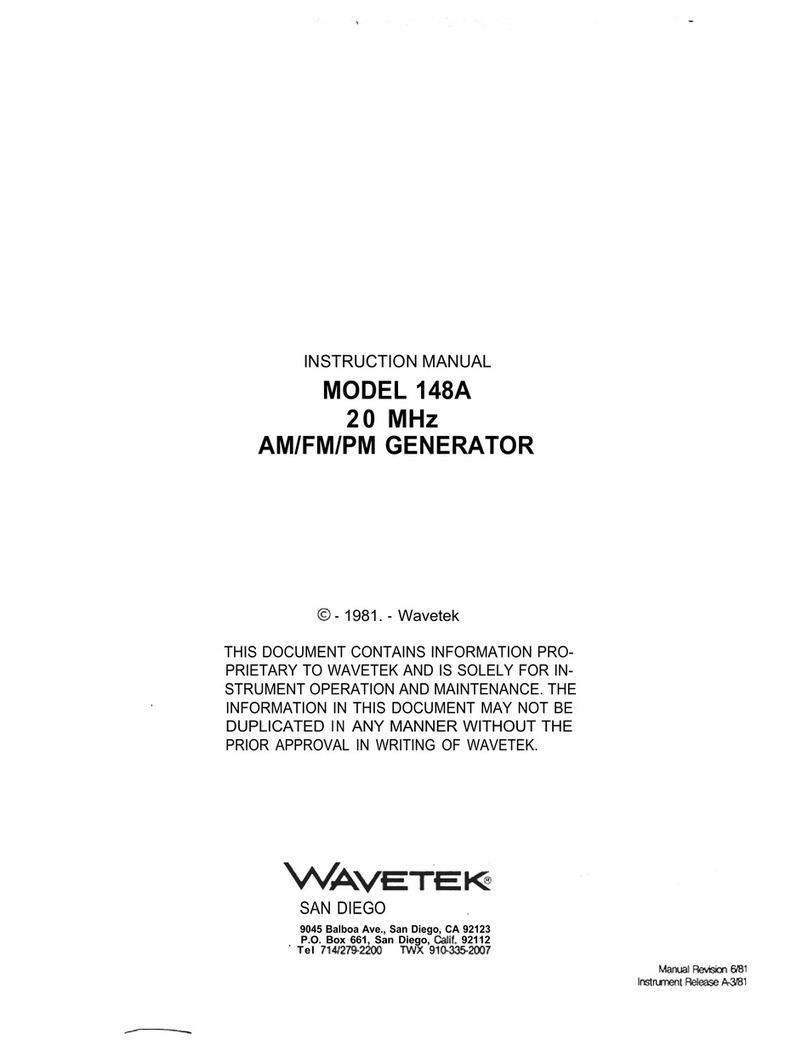
Wavetek
Wavetek 148A User manual
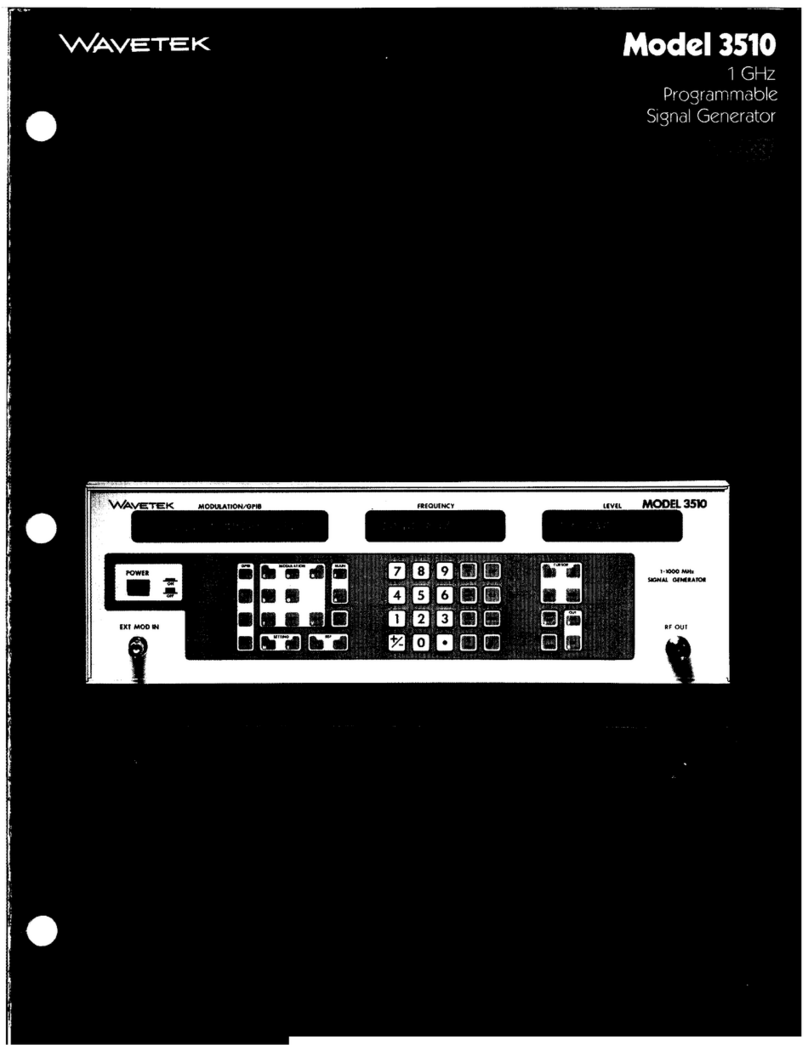
Wavetek
Wavetek 3510 User manual
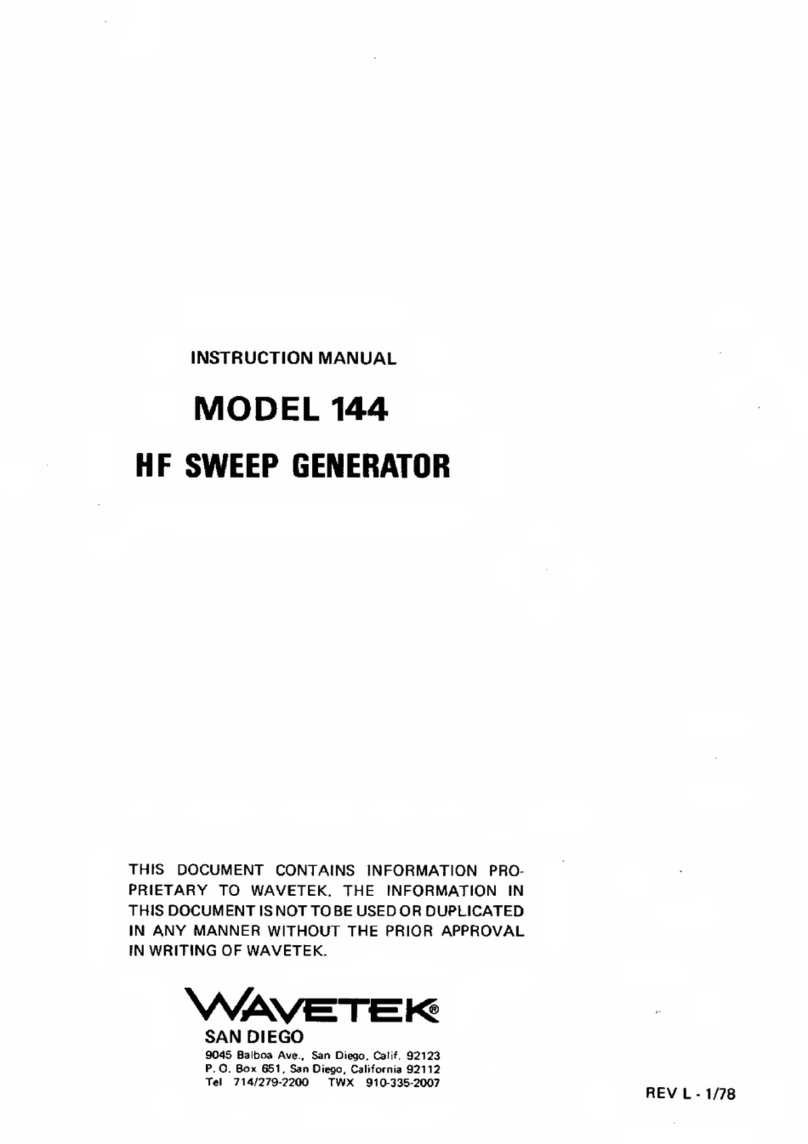
Wavetek
Wavetek 144 User manual
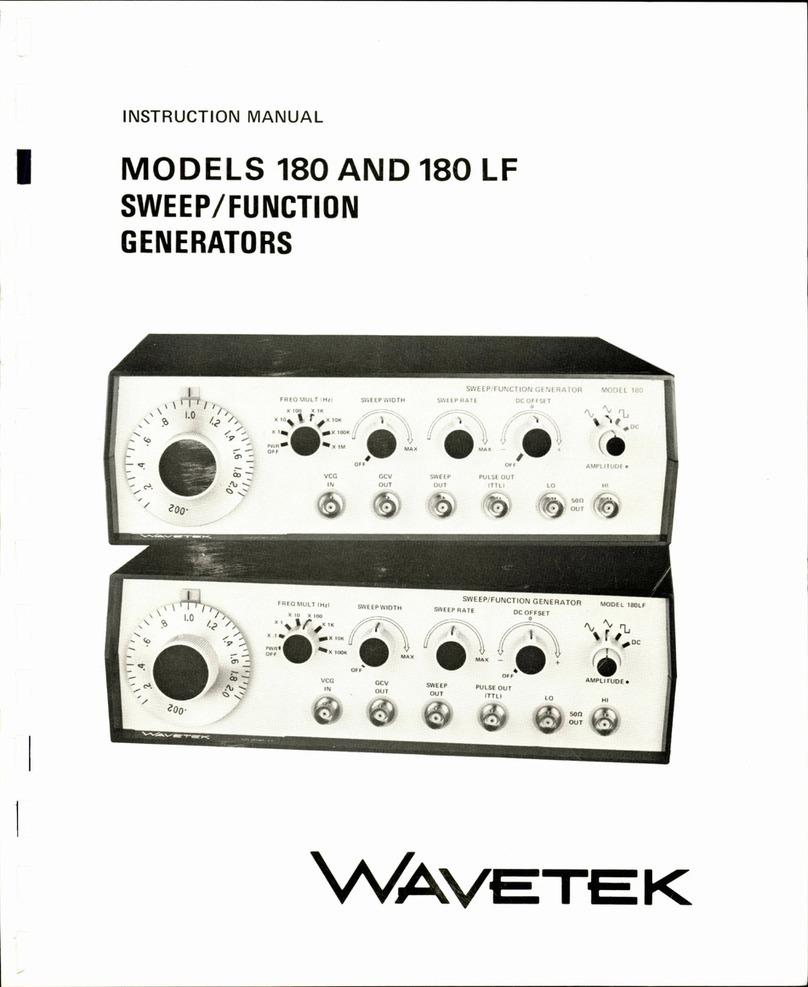
Wavetek
Wavetek 180 User manual
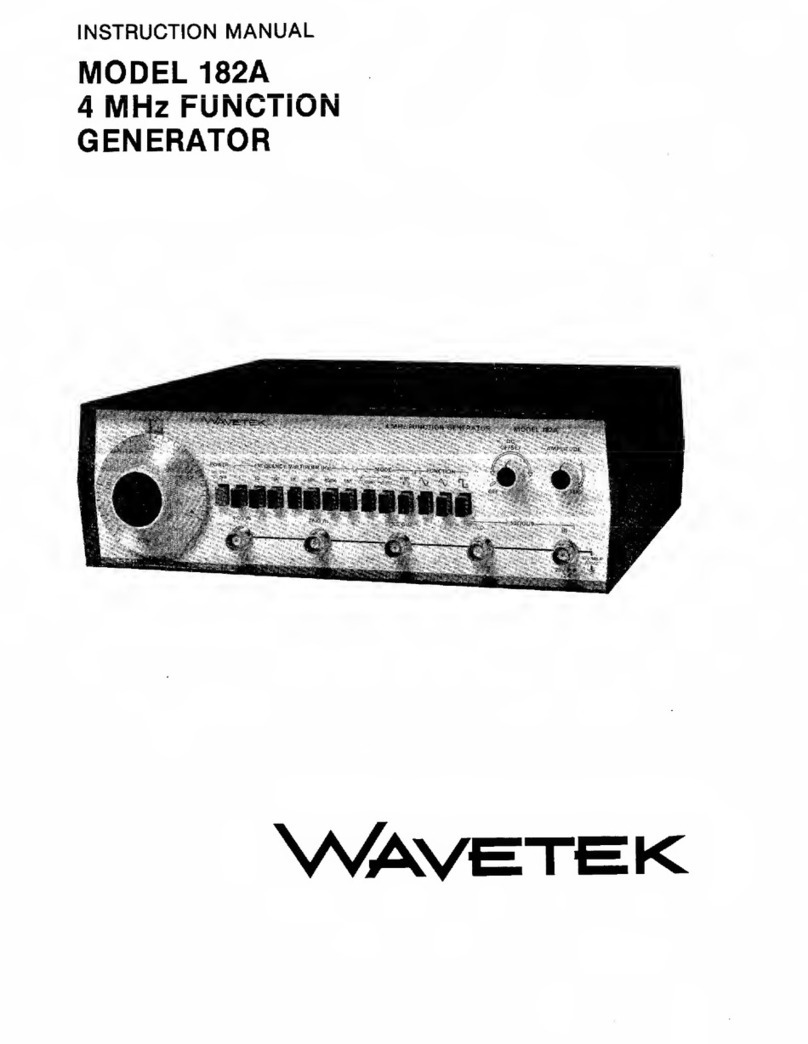
Wavetek
Wavetek 182A User manual
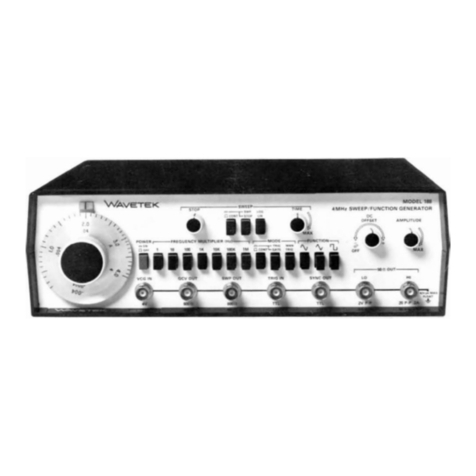
Wavetek
Wavetek 188 User manual
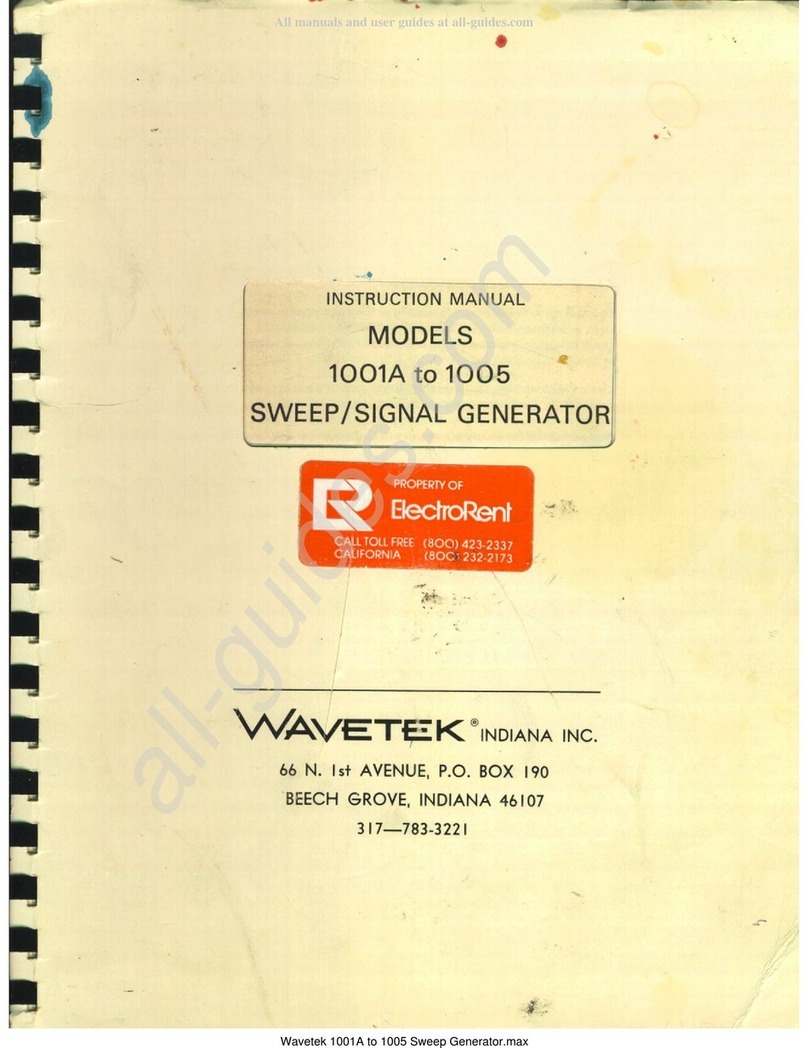
Wavetek
Wavetek 1001A User manual
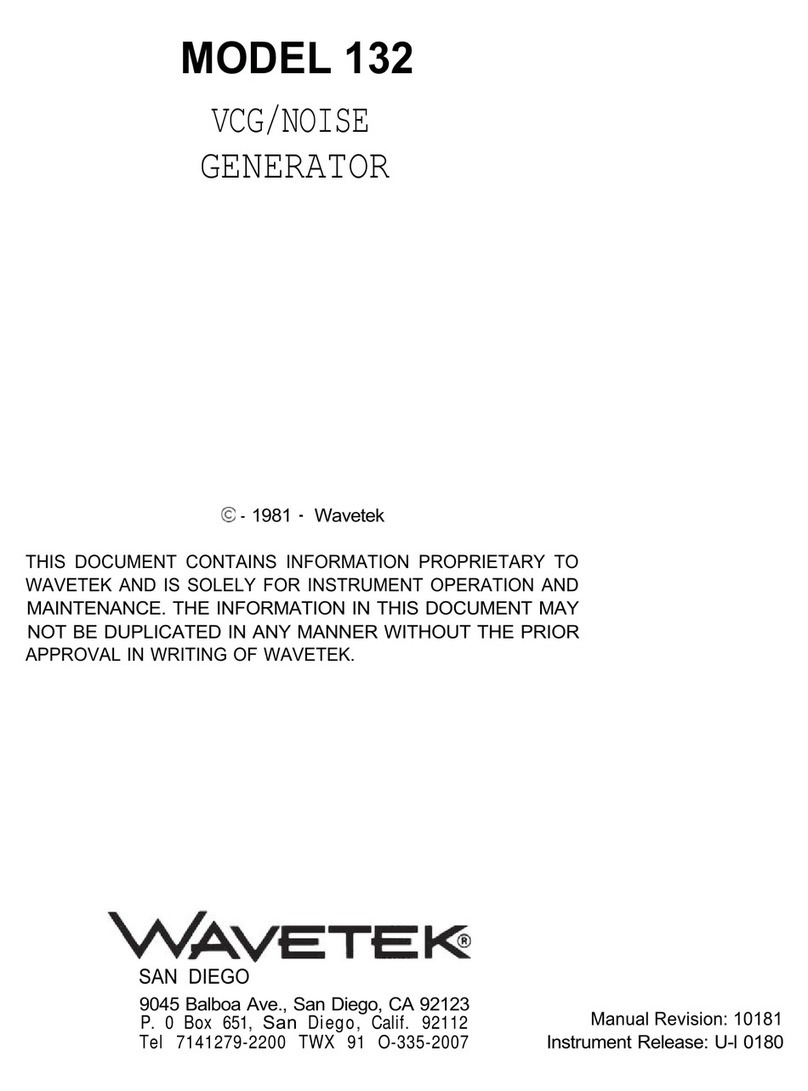
Wavetek
Wavetek 132 User manual
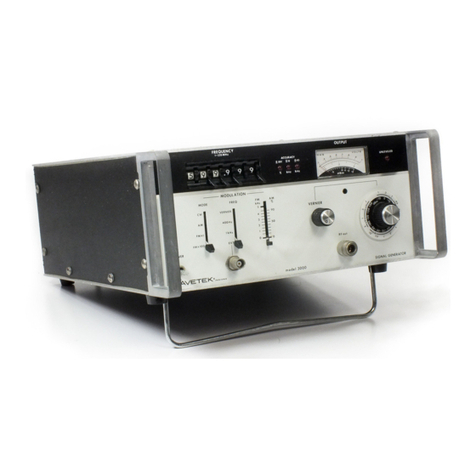
Wavetek
Wavetek 3000 User manual
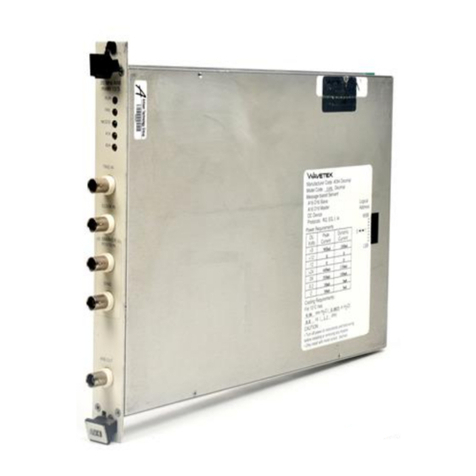
Wavetek
Wavetek 1370 Installation instructions


